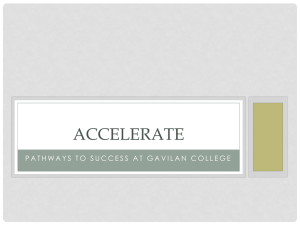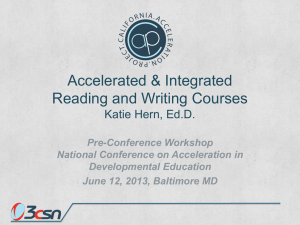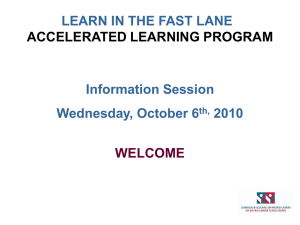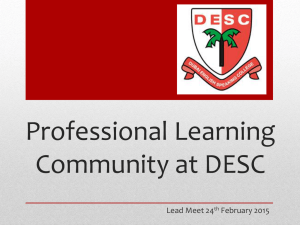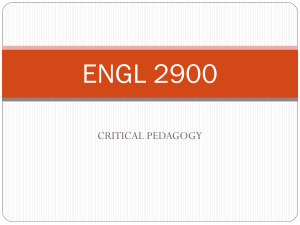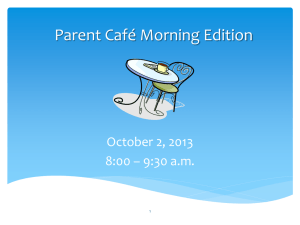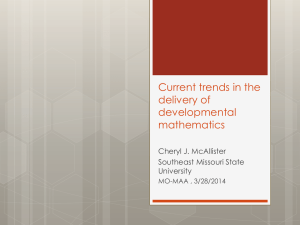The Pedagogy of Acceleration: Classroom Practices in Pilot English
advertisement
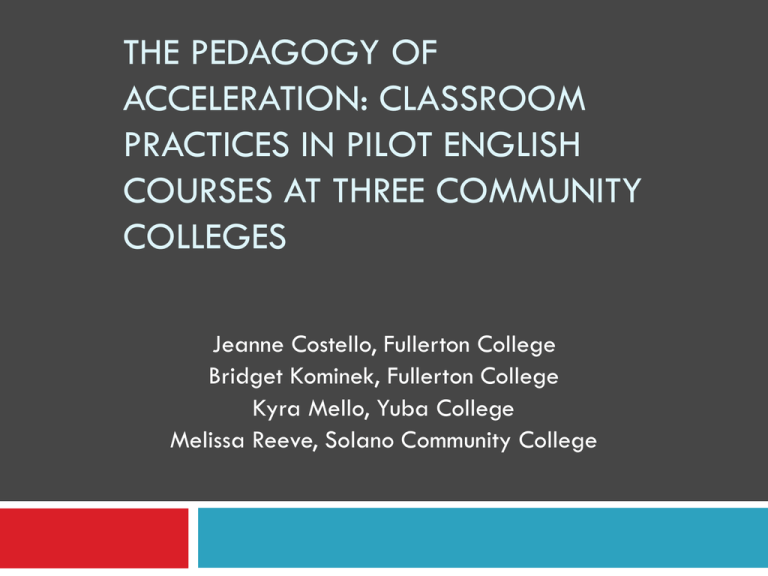
THE PEDAGOGY OF ACCELERATION: CLASSROOM PRACTICES IN PILOT ENGLISH COURSES AT THREE COMMUNITY COLLEGES Jeanne Costello, Fullerton College Bridget Kominek, Fullerton College Kyra Mello, Yuba College Melissa Reeve, Solano Community College Introduction Who we are How we met: California Acceleration Project http://cap.3csn.org/ Presentation Outline Our acceleration pilots and emerging data Overview of the strategies Attending to the affective domain Intensified reading Just-in-time remediation Small-group breakout discussion of strategies Gallery walk Fullerton College: Pilot Model We took four sections of English 59 (two levels below transfer, the second in three pre-transfer developmental English classes in our composition sequence) and made them pilots in our exploration of acceleration. We teach the course using accelerated pedagogy while still meeting the requirements of the current course outline for the traditional course. This pilot will run through next year, while a new, permanent accelerated course is being created and fine-tuned. The pilot sections will be replaced by a permanent accelerated course (English 99) in the fall 2014 semester (pending approval). We are using an existing “pop-up” process to move approved students into English 100 until the permanent English 99 course is approved. We forward the names and student ID numbers of approved students to our dean and the counseling division on our campus. They are manually cleared to register for 100 without having to take English 60. This process is already used to manage “misplaced” students in the developmental sequence. Fullerton College: Emerging Data Results for Spring 2012 Semester: Total number of students to complete the pilot course in spring 2012: 90 (of the 102 who started it) Total number of students approved for English 100: 60, 59% of those who started the course Total number of students approved for English 60: 20, 20% of those who started the course Total number of students who did not pass English 59: 22, 22% of those who started the course The course had an 88% retention rate and a 79% success rate (students passing to 100 or 60) Yuba College: Pilot Model Yuba College’s traditional development sequence contained four levels of developmental writing courses. Additionally, Yuba College had a separate sequence of four developmental reading courses. Although the Reading courses were not required for transfer or graduation, many students enrolled in the courses. Success and persistence rates were extremely low in both sequences. English Course Sequence Option #1 Integrated reading and writing 4 levels below transfer Integrated reading and writing 3 levels below transfer Traditional 2 levels below transfer Traditional 1 level below transfer Transfer requirement English Course Sequence Option #2 Accelerated, Compressed, and integrated reading and writing 3 levels below transfer Traditional 2 levels below transfer Traditional 1 level below transfer By integrating reading and writing at the bottom levels, we were able to eliminate parts of the separate, isolated reading sequence. Transfer requirement Yuba College: Emerging Data Solano Community College: Pilot Model Traditional Sequence: Three levels with departmental exam required for advancement at each level: 305 355 + 355L 370+ 370L English 1 Class + lab + exam + persistence = 3-4 exit points per level below transfer Accelerated Model: 5-unit, open-access class, no lab co-requisite Departmental Exam rolled into coursework portfolio 3 exit points: finish, pass, and persist to Eng. 1 Solano Community College: Emerging Data First-year pilot: Fall ‘11: 35 % pass rate (3 sections) Spring ‘12: 42% pass rate (4 sections) No data yet available on persistence or passing Eng. 1 My Spring 2012 class: 24 students @ census; 20 completed the term 13 passed overall (54%) Intake placement 1 level below: 61% passed Intake placement 2 levels below: 55% passed Intake placement 3 levels below: 100% (2) qualified to skip one level & move to Eng. 370 Discussion of Data Questions or comments about the data we’ve shared? Three Aspects of Accelerated Pedagogy Attention to the Affective Domain Intensified Reading Just-in-Time Remediation Attention to the Affective Domain What is it? What does it mean? How is it different from conventional developmental pedagogy? Why does it matter? Intensified Reading What is it? What does it mean? How is it different from conventional developmental pedagogy? Why does it matter? Just-in-Time Remediation What is it? What does it mean? How is it different from conventional developmental pedagogy? Why does it matter? Small-Group Breakout Session You have been broken up into four groups. You will have fifteen minutes to discuss the first strategy you’ve been given. Your goal is to come up with specific ways to incorporate this strategy into an accelerated class. You can share examples that you already use in your class or you can brainstorm new strategies that you come up with. As you discuss ideas, have one member of your group take notes on the poster. In a few minutes, one of the presenters will join your group to share our specific strategies and participate in the discussion. Small-Group Breakout Session Now, move on to the next strategy your group has been assigned. Your goal is to come up with specific ways to incorporate this strategy into an accelerated class. You can share examples that you already use in your class, or you can brainstorm new strategies that you come up with. As you discuss ideas, have one member of your group take notes on the poster. In a few minutes, one of the presenters will join your group to share our specific strategies and participate in the discussion. Whole Group Debrief Individually, jot down your name, email address, institution, and one concrete goal you will work to achieve in your class, teaching practice or campus effort related to acceleration. Use the post-it notes provided at your table. Whole Group Debrief Put your post-it notes on the wall next to your group’s discussion notes. Take the last few minutes of the session to do a gallery walk: go around and read and discuss the other teams’ discussion notes and individual goals. As you walk around, take time to connect with people who have goals that are similar to your own or that complement yours. How might you work together?
